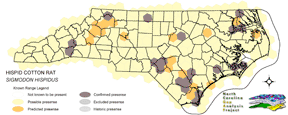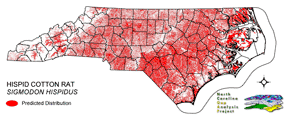
| Taxa: |
| Order: |
| Family: |
| Mammalia |
| Rodentia |
| Muridae |
| NatureServe Global Rank: |
| NatureServe State (NC) Rank: |
| G5 |
| S5 |
| Federal Status: |
| NC State Status: |
| --- |
| --- |


| Land Unit |
| US Fish & Wildlife Service |
| US Forest Service |
| US National Park Service |
| US Department of Defense |
| NC State Parks |
| NC University System |
| NC Wildlife Res. Com. |
| NC Forest Service |
| NC Div. of Coastal Mgmt. |
| Local Governments |
| Non-Governmental Org. |
| Other Public Lands |
| Private Lands |
| GAP Status 1-2 |
| All Protected Lands |
| Statewide |
| Hectares |
| 24,317.73 |
| 17,837.64 |
| 77,425.92 |
| 11,918.07 |
| 8,029.26 |
| 4,433.13 |
| 32,910.21 |
| 4,857.99 |
| 1,768.23 |
| 1,330.74 |
| 5,142.33 |
| 3,487.05 |
| 5,236,818.39 |
| 58,174.26 |
| 190,767.48 |
| 5,430,276.69 |
| Acres |
| 60,090.41 |
| 44,077.76 |
| 191,323.58 |
| 29,450.19 |
| 19,840.73 |
| 10,954.50 |
| 81,322.88 |
| 12,255.51 |
| 4,369.39 |
| 3,288.33 |
| 12,706.97 |
| 8,616.69 |
| 12,940,457.54 |
| 144,002.86 |
| 471,647.78 |
| 13,418,754.47 |
| % of Dist. on |
| Prot. Lands |
| 12.7 % |
| 9.4 % |
| 40.2 % |
| 6.2 % |
| 4.2 % |
| 2.3 % |
| 16.7 % |
| 2.5 % |
| 0.9 % |
| 2.6 % |
| 2.6 % |
| 1.5 % |
| < 0.1 % |
| 30.5 % |
| ----- |
| ----- |
| % of Dist. on |
| All Lands |
| 0.4 % |
| 0.3 % |
| 1.4 % |
| 0.2 % |
| 0.1 % |
| < 0.1 % |
| 0.6 % |
| < 0.1 % |
| < 0.1 % |
| < 0.1 % |
| < 0.1 % |
| < 0.1 % |
| 96.4 % |
| 1.1 % |
| ----- |
| ----- |
|
Often the most common small rodent of open farm and old field habitats in the southeastern United States (Whitaker and Hamilton 1998). In North Carolina, the cotton rat is most abundant in the lower piedmont and coastal plain, and less abundant in the valley areas of the southern Appalachian mountains (Lee et al. 1982, Whitaker and Hamilton 1998). It also
can be found in low abundance in dune sea-oat and maritime-scrub communities of the Outer Banks. It is consistently among the most captured species in virtually all sparsely forested to open habitats (including hedgerows near cultivated fields, pastures, old fields, roadways, grassy openings in woodlands and forest edges). Semi-open brushy or viney areas where some grass is present, and watery habitats containing emergent grasses, reeds and sedges are also suitable for the cotton rat (Brown 1997, Whitaker and Hamilton 1998). Areas of tall dense herbaceous vegetation, particularly broom sedge fields, appear to be preferred habitat, but few open habitats do not harbor at least small populations (Whitaker and Hamilton 1998). Trails through the grass and forb groundcover are often very distinctive and noticeable. In more barren spots, these trails can be readily seen from a distance. NATURE SERVE GLOBAL HABITAT COMMENTS: Favors dense, grassy fields and roadside edges; also in brushy or weedy areas or among reeds and cattails along streams or ponds, in irrigated fields, and in desertscrub with little grass. Nests typically are built under logs, rocks, underground. |
| Code | Name | Description | NC Natural Heritage Program Equivalent |
| 3 | Tidal Marsh | Fresh and brackish tidal marshes, including cord grass, wild rice, sawgrass and needlerush alliances. | Brackish Marsh, Interdune pond, Maritime wet grassland |
| 124 | Maritime Scrubs and Tidal Shrublands | Coastal shrubs including wax-myrtle, swamp rose, alder, yaupon, and greenbriar. | Maritime Shrubs, Salt Shrub |
| 372 | Interdune Herbaceous Wetlands | Dune swales with permanently flooded to intermittently exposed hydrology. Species composition depends on salinity and can include cut grass, spike-rush, mosquito fern, and hornwort. | Interdune Pond, Maritime Wet Grasslands |
| 371 | Maritime Grasslands | Dune grass community consisting of sea oats and beach grasses. | Dune grass, Maritime dry grassland |
| 97 | Mesic Longleaf Pine | Longleaf pine woodlands without a major scrub oak component. Slash or loblolly pines may be present as well. | Mesic Pine Flatwoods |
| 42 | Xeric Longleaf Pine | Sandhills including a range of longleaf pine density from predominantly wiregrass, scrub oak dominated to true longleaf pine woodland. This does not include mesic or saturated flatwood types. | Xeric Sandhill Scrub, Pine/Scrub Oak Sandhill, Coastal Fringe Sandhill |
| 46 | Xeric Oak - Pine Forests | Mixed forest dominated by yellow pines with white or northern red oaks co-dominating. | Pine Oak Heath |
| 232 | Xeric Pine-Hardwood Woodlands and Forests | Mixed forest dominated by yellow pines with drier oaks including southern red, post, and chestnut oaks. | Dry Oak Hickory Forest |
| 226 | Piedmont Xeric Woodlands | Generally post and blackjack oak dominated woodlands. White ash and pignut hickory can be found in combination with Eastern red cedar on glades. | Xeric Hardpan Forest |
| 20 | Coniferous Regeneration | Regenerating pine stands. Predominantly loblolly pine, but slash and longleaf stands occur as well. | No equivalent |
| 36 | Successional Deciduous Forests | Regenerating deciduous trees with a shrub stature. Commonly dominated by sweetgum, tulip poplars and maples. | No equivalent |
| 180 | Agricultural Crop Fields | Farm fields used for row crops. | No equivalent |
| 205 | Agricultural Pasture/Hay and Natural Herbaceous | Farm fields used for pasture grass or hay production, as well as old fields dominated by native and exotic grasses. | No equivalent |
| 202 | Residential Urban | Includes vegetation interspersed in residential areas. Includes lawns, mixed species woodlots, and horticultural shrubs. Vegetation accounts for between 20 - 70% of the cover. | No equivalent |
| 203 | Urban Low-Intensity Developed | Highly developed areas with vegetation accounting for < 20% of the cover. | No equivalent |
| 204 | Urban High-Intensity Developed and Transportation Corridors | Highly developed areas including infrastructure such as roads, railroads. Vegetation represents < 20% of the cover. | No equivalent |
|
Cameron, G.N. and S.R. Spencer. 1981. Sigmodon hispidus. Am. Soc. Mamm., Mammalian Species No. 158. 9 pp.
Childs, J. E., J. N. Mills, and G. E. Glass. 1995. Rodent-borne hemorrhagic fever viruses:a special risk for mammalogists? Journal of Mammalogy 76:664-680. Jones, J. K., Jr., et al. 1992. Revised checklist of North American mammals north of Mexico, 1991. Occas. Pap. Mus., Texas Tech Univ. (146):1-23. Voss, R. S. 1992. A revision of the South American species of SIGMODON (Mammalia:Muridae) with notes on their natural history and biogeography. Am. Mus. Novitates 3050:1-56. McMurry, S. T., et al. 1994. Demographic profiles of populations of cotton rats in a continuum of habitat types. J. Mamm. 75:50-59. Cameron, G.N., W.B. Kincaid, and B.A. Carnes. 1979. Experimental species removal:temporal activity patterns of Sigmodon hispidus and Reithrodentomys fulvescens. J. Mamm. 60:195-197. Wilson, D. E., and D. M. Reeder (editors). 1993. Mammal Species of the World:a Taxonomic and Geographic Reference. Second Edition. Smithsonian Institution Press, Washington, DC. xviii + 1206 pp. Brown, L. N. 1997. A guide to the mammals of the southeastern United States. University of Tennessee Press, Knoxville. xiv + 236 pp. Whitaker, J.O. Jr. and W.J. Hamilton, Jr. 1998. Mammals of the eastern United States. Cornell Univ. Press, Ithaca, New York. 583 pp. Lowery, G. H., Jr. 1974. The mammals of Louisiana and its adjacent waters. Louisiana State University Press, Baton Rouge. 565 pp. Blood, B. R. 1990. Taxonomy and distribution of SIGMODON in California. Bull. Southern California Acad. Sci. 89:86-93. Lee, D. S., L. B. Funderburg Jr., and M. K. Clark. 1982. A distributional survey of North Carolina mammals. Occasional Papers of the North Carolina Biological Survey, No. 1982-10. North Carolina State. Mus. Nat. Hist., Raleigh, North Carolina. 72 pp. Davis, W. B. 1978. The mammals of Texas. Texas Parks and Wildlife Dept., Bull. No. 41. 294 pp. Hamilton, William J., Jr., and John O. Whitaker, Jr. 1979. Mammals of the eastern United States. Cornell Univ. Press, Ithaca, New York. 346 pp. Hall, E. R. 1981. The Mammals of North America. Second edition. 2 Volumes. John Wiley and Sons, New York, New York. Schwartz, Charles W., and Elizabeth R. Schwartz. 1981. The wild mammals of Missouri. University of Missouri Press, Columbia. 356 pp. Webster, W. D., J. F. Parnell and W. C. Biggs Jr. 1985. Mammals of the Carolinas, Virginia, and Maryland. The University of North Carolina Press, Chapel Hill, NC. Hoffmeister, D. F. 1986. Mammals of Arizona. Univ. Arizona Press and Arizona Game and Fish Dept. 602 pp. Caire, W., J. D. Tyler, B. P. Glass, and M. A. Mares. Z. Marsh (illustrator). 1989. Mammals of Oklahoma. University of Oklahoma Press, Norman. Oklahoma. 567 pp. Zimmerman, E. G. 1970. Karyology, systematics and chromosome evolution in the rodent genus, SIGMODON. Publ. Michigan State Univ., Biol. Serv. 4:385-454. |
For more information please contact them at:
NC-GAP Analysis Project
Dept. of Zoology, NCSU
Campus Box 7617
Raleigh, NC 27695-7617
(919) 513-2853
www.basic.ncsu.edu/ncgap